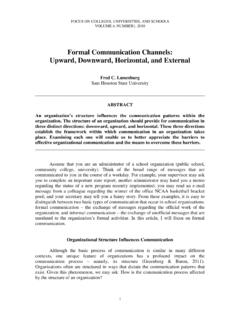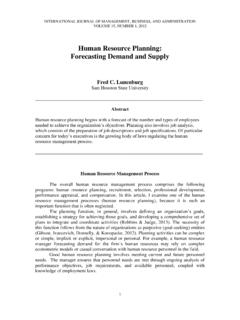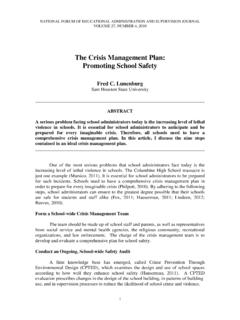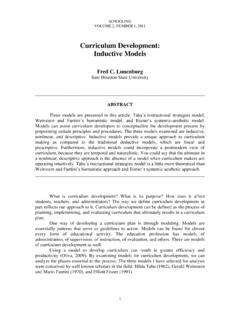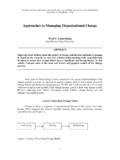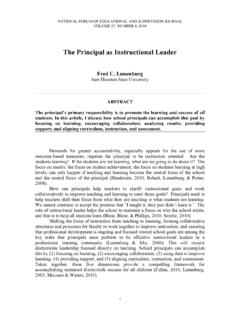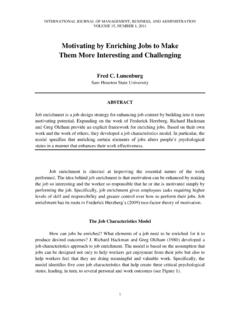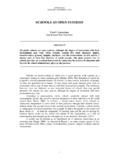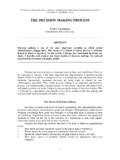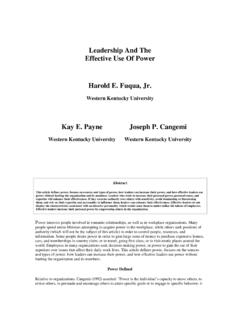Transcription of Curriculum Models for Preschool Education: Theories and ...
1 SCHOOLING VOLUME 2, NUMBER 1, 2011 1 Curriculum Models for Preschool Education: Theories and Approaches to Learning in the Early Years Fred C. Lunenburg Sam Houston State University _____ ABSTRACT A valid Curriculum model provides the theoretical framework needed to operate an effective Preschool education program. In this article, I examine six widely known early education Curriculum Models including the Bank Street developmental-interaction approach, the dodge creative Curriculum for Preschool , the High/Scope Curriculum , the Kamii-DeVries constructivist approach, the Montessori method, and the direct instruction model.
2 No attempt was made to compare and contrast the Curriculum Models . _____ Every educator knows that a valid Curriculum model provides the theoretical framework needed to operate an effective Preschool education program (Miller, 2011) and to provide opportunities for children to be ready to learn (Bauman, 2012). Educators might consider six widely known early childhood Curriculum Models : the Bank Street developmental-interaction approach, the dodge creative Curriculum for Preschool , the High/Scope Curriculum , the Kamii-DeVries constructivist approach, the Montessori method, and the direct instruction model.
3 Bank Street Developmental-Interaction Approach The Bank Street Developmental-Interaction approach is named for the Bank Street college of Education in New York city , which offers graduate degrees in education. Influenced by the educational philosophy of John Dewy, Lucy Sprague Mitchell (2000) formulated the approach s central tenet of development of the whole child through active learning. From 1928 on, Barbara Biber used psychodynamic theory to shape the approach. Later, Bank Street formulated a Curriculum model for the federal Follow Through early education project (Rose, 2010; Spring, 2007).
4 Bank Street encourages teachers to use their own judgment about educational practices in light of SCHOOLING 2_____ their understanding and observation of children s development (Biber, 1984; Hesse-Biber & Nagy, 2011). dodge Creative Curriculum for Preschool The Creative Curriculum for Preschool was developed by Diane Trister dodge . The approach is based on her career in working with Preschool educators. The approach helps teachers to make their practices consistent with their goals for children by arranging their classrooms to support teachers developmentally appropriate practice and children s active learning, which is directed toward their social competence.
5 Teachers arrange the learning environment into ten interest areas: art, blocks, cooking, computers, house corner, library corner, music and movement, the outdoors, sand and water, and table toys ( dodge , 2010a). dodge first presented the Creative Curriculum in 1979 and founded Teaching Strategies, Incorporated for this purpose. She has provided a parent s guide for building the baby s brain during the first five years of life ( dodge , 2000a); an accompanying creative Curriculum for infants, toddlers, and two-year olds ( dodge 2010b); and a creative Curriculum for family child care (2009).
6 Creative Curriculum specialties acknowledge that support by trainers is desirable ( dodge , 1988, 2000b); however, teachers learn the Creative Curriculum primarily through self-instruction rather than through training. The High/Scope Curriculum The High/Scope Curriculum was developed in the 1960 s and 1970 s by the High/Scope Educational Research Foundation staff led by David P. Weikart (Hohmann, Banet, & Weikart, 1979; Hohmann & Weikart, 1995; Weikart, 1997). Based on Piaget s constructivist theory of child development (Piaget, 1970), the High/Scope Curriculum initially focused on disadvantaged Preschool children (Weikart, 2005).
7 The approach now encompasses all children and every type of Preschool setting (Brickman, 2004a, 2004b, 2005; Kruse, 2006; Rush, 2009). The High/Scope Curriculum advocates active learning and classrooms that are arranged with discrete, well-equipped interest areas (Epstein, 2006). Each day, children engage in a consistent routine that consists of time for children to plan, carry out, and reflect on their own learning as well as time to engage in small-and-large group activities. Adults support children s active learning by organizing the environment and establishing a consistent daily routine; establishing a supportive social climate; encouraging children s intentional activities, problem solving, and verbal reflections; planning small-and-large group learning experiences; and interpreting children s actions in terms of the High/Scope key experiences in child development.
8 High/Scope has identified 58 key experiences in child development for the Preschool years. The key experiences are grouped into ten categories: creative representation, language and literacy, initiative and social relations, movement, music, classification, seriation, number, space, and time. FRED C. LUNENBURG _____3 Kamii-DeVries Constructivist Perspective The Kamii-DeVries Constructivist Perspective was developed by Constance Kamii and Rhetta DeVries (DeVries & Kamii, 2001; DeVries & Kohlberg, 1994; Kamii & DeVries, 1980, 1991, 1993, 1999).
9 The perspective is based on Piaget s constructivist principle that children develop their knowledge, intelligence, morality, and personality from their interactions with the world within a logical-mathematical framework. Physical activity provides a vehicle through which children learn through mental action. A child-centered approach is used by teachers who are well grounded in traditional Preschool education. Teachers prepare the setting for active learning, remain in touch with what children are thinking, respond to children on their perspective, and help children extend their ideas.
10 The more recent extensions of the theory include using technology evaluation to enhance student learning (Kamii & DeVries, 2003) and using the constructivist approach to physics with young children (DeVries, & Kamii, 2011). Montessori Method The Montessori Method was developed by Maria Montessori (Lindauer, 1993; Schwegman, 2011), a physician working with poor children in Italy. The Montessori method which aims at developing children s senses, academic skills, practical life skills, and character is the world s oldest extant early childhood Curriculum model and is used today by Montessori teachers throughout the world.
